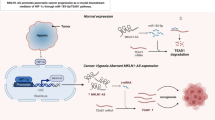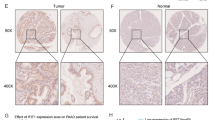Abstract
Neuronal regeneration related protein (NREP), also known as P311, has been reported to participate in multiple biological processes. The detection of tumor biomarker favored a non-invasive early entry for cancer diagnosis and disease monitoring to prevent its worsening symptoms. This study is intended to investigate the clinical roles of NREP in gastric cancer (GC) and its effect on gastric cancer cell proliferation and angiogenesis. Our results demonstrated that NREP was typically upregulated in GC tissues compared with normal control. The Kaplan–Meier analysis showed correlations between increased NREP level and poor survival, indicating the prognostic value of NREP in GC patients. The expression levels of NREP varied by races, clinical T stages, and histologic grades. NREP expression was associated with tumor-associated immune infiltration. The NREP expression was powerfully associated with clinical characteristics of GC patients, in particular, with T stage and histologic grade. Gene ontology and KEGG signaling analysis indicated that NREP-related genes were predominantly enriched in various pathways. Additionally, knockdown of NREP inhibited human gastric adenocarcinoma cell proliferation and angiogenesis. Collectively, our results suggested that NREP may be an excellent biomarker for the clinical diagnosis, prognosis, and therapy of GC.








Similar content being viewed by others
Data Availability
The datasets generated during and/or analyzed during the current study are available from the corresponding author on reasonable request.
References
Chen B, Zhang J, Ma Q (2021) The relationship between the simultaneity present of caga and hopqi genes in helicobacter pylori and the risk of gastric cancer (Noisy-le-Grand, France). Cell Mol Biol (noisy-Le-Grand) 67:121–126
Dai Y, Yang G, Yang L, Jiang L, Zheng G, Pan S, Zhu C (2021) Expression of Foxa1 gene regulates the proliferation and invasion of human gastric cancer cells. Cell Mol Biol 67:161–165
Demircioglu F, Wang J, Candido J, Costa ASH, Casado P, de Luxan Delgado B, Reynolds LE, Gomez-Escudero J, Newport E, Rajeeve V, Baker AM, Roy-Luzarraga M, Graham TA, Foster J, Wang Y, Campbell JJ, Singh R, Zhang P, Schall TJ, Balkwill FR, Sosabowski J, Cutillas PR, Frezza C, Sancho P, Hodivala-Dilke K (2020) Cancer associated fibroblast Fak regulates malignant cell metabolism. Nat Commun 11:1290
Du Y, Zhang JY, Gong LP, Feng ZY, Wang D, Pan YH, Sun LP, Wen JY, Chen GF, Liang J, Chen JN, Shao CK (2022) Hypoxia-induced Ebv-Circlmp2a promotes angiogenesis in Ebv-associated gastric carcinoma through the Khsrp/Vhl/Hif1α/Vegfa pathway. Cancer Lett 526:259–272
Espinosa-Parrilla Y, Munoz X, Bonet C, Garcia N, Vencesla A, Yiannakouris N, Naccarati A, Sieri S, Panico S, Huerta JM, Barricarte A, Menendez V, Sanchez-Cantalejo E, Dorronsoro M, Brennan P, Duarte-Salles T, B As Bueno-de-Mesquita H, Weiderpass E, Lund E, Clavel-Chapelon F, Boutron-Ruault MC, Racine A, Numans ME, Tumino R, Canzian F, Campa D, Sund M, Johansson M, Ohlsson B, Lindkvist B, Overvad K, Tjonneland A, Palli D, Travis RC, Khaw KT, Wareham N, Boeing H, Nesi G, Riboli E, Gonzalez CA, Sala N (2014) Genetic association of gastric cancer with mirna clusters including the cancer-related genes Mir29, Mir25, Mir93 and Mir106: results from the epic-eurgast study. Int J Cancer 135:2065–2076
Guimaraes EL, Stradiot L, Mannaerts I, Schroyen B, van Grunsven LA (2015) P311 modulates hepatic stellate cells migration. Liver Int 35:1253–1264
Guo X, Yin B, Wang C, Huo H, Aziziaram Z (2021) Risk assessment of gastric cancer in the presence of helicobacter pylori caga and hopqii genes. Cell Mol Biol 67:299–305
Jemal A, Bray F, Center MM, Ferlay J, Ward E, Forman D (2011) Global cancer statistics. CA Cancer J Clin 61:69–90
Kim HH, Han SU, Kim MC, Kim W, Lee HJ, Ryu SW, Cho GS, Kim CY, Yang HK, Park DJ, Song KY, Lee SI, Ryu SY, Lee JH, Hyung WJ, G Korean Laparoendoscopic Gastrointestinal Surgery Study (2019) Effect of laparoscopic distal gastrectomy vs open distal gastrectomy on long-term survival among patients with stage I gastric cancer: the Klass-01 randomized clinical trial. JAMA Oncol 5:506–513
Li H, Yao Z, He W, Gao H, Bai Y, Yang S, Zhang L, Zhan R, Tan J, Zhou J, Takata M, Wu J, Luo G (2016) P311 induces the transdifferentiation of epidermal stem cells to myofibroblast-like cells by stimulating transforming growth factor beta1 expression. Stem Cell Res Ther 7:175
Li X, Pasche B, Zhang W, Chen K (2018) Association of muc16 mutation with tumor mutation load and outcomes in patients with gastric cancer. JAMA Oncol 4:1691–1698
Li M, Zheng G, Yu L, Tan LL, Li X, Li MJ, Li C, Li S, Liang J, Zhong Z, Li ZM (2021) Diagnostic value of Mri-Dwi signal intensity value combined with Serum Pgi, Pgii and Ca199 in early gastric cancer (Noisy-le-Grand, France). Cell Mol Biol (noisy-Le-Grand) 67:95–100
Liu Y, Zhou X, Hu N, Wang C, Zhao L (2020) P311 regulates distal lung development via its interaction with several binding proteins. Mech Dev 163:103633
Mariani L, McDonough WS, Hoelzinger DB, Beaudry C, Kaczmarek E, Coons SW, Giese A, Moghaddam M, Seiler RW, Berens ME (2001) Identification and validation of P311 as a glioblastoma invasion gene using laser capture microdissection. Cancer Res 61:4190–4196
McDonough WS, Tran NL, Berens ME (2005) Regulation of glioma cell migration by serine-phosphorylated P311. Neoplasia 7:862–872
Nunez S, Young C, Adebayo O, Muppuru KM, Badri KR (2019) P311, a Novel intrinsically disordered protein, regulates adipocyte development. Biochem Biophys Res Commun 515:234–240
Ooi PT, da Costa N, Edgar J, Chang KC (2006) Porcine congenital splayleg is characterised by muscle fibre atrophy associated with relative rise in Mafbx and fall in P311 expression. BMC Vet Res 2:23
Pan D, Zhe X, Jakkaraju S, Taylor GA, Schuger L (2002) P311 induces a Tgf-Beta1-independent, nonfibrogenic myofibroblast phenotype. J Clin Invest 110:1349–1358
Smyth EC, Nyamundanda G, Cunningham D, Fontana E, Ragulan C, Tan IB, Lin SJ, Wotherspoon A, Nankivell M, Fassan M, Lampis A, Hahne JC, Davies AR, Lagergren J, Gossage JA, Maisey N, Green M, Zylstra JL, Allum WH, Langley RE, Tan P, Valeri N, Sadanandam A (2018) A Seven-gene signature assay improves prognostic risk stratification of perioperative chemotherapy treated gastroesophageal cancer patients from the magic trial. Ann Oncol 29:2356–2362
Stradiot L, Mannaerts I, van Grunsven LA (2018) P311, friend, or foe of tissue fibrosis? Front Pharmacol 9:1151
Sun YG, Gao YJ, Zhao ZQ, Huang B, Yin J, Taylor GA, Chen ZF (2008) Involvement of P311 in the affective, but not in the sensory component of pain. Mol Pain 4:23
Sun W, Powell M, O’Dwyer PJ, Catalano P, Ansari RH, Benson AB 3rd (2010) Phase Ii study of sorafenib in combination with docetaxel and cisplatin in the treatment of metastatic or advanced gastric and gastroesophageal junction adenocarcinoma: ecog 5203. J Clin Oncol 28:2947–2951
Tan J, Peng X, Luo G, Ma B, Cao C, He W, Yuan S, Li S, Wilkins JA, Wu J (2010) Investigating the role of P311 in the hypertrophic scar. PLoS ONE 5:e9995
Taylor GA, Rodriguiz RM, Greene RI, Daniell X, Henry SC, Crooks KR, Kotloski R, Tessarollo L, Phillips LE, Wetsel WC (2008) Behavioral characterization of P311 knockout mice. Genes Brain Behav 7:786–795
Wang G, Jiang X (2021) Effect of precede-proceed-model-based health education on the life quality and 5-Htt gene expression of patients with gastric cancer after surgery. Cell Mol Biol 67:242–248
Wang S, Zhang X, Qian W, Zhou D, Yu X, Zhan R, Wang Y, Wu J, He W, Luo G (2017) P311 deficiency leads to attenuated angiogenesis in cutaneous wound healing. Front Physiol 8:1004
Wang C, Jiang T, Zhu Y (2021) Experimental study on anti angiogenesis of recombinant mouse angiostatin gene in mice with gallbladder carcinoma. Cell Mol Biol 67:117–124
Yang ZQ, Liu YJ, Zhou XL (2020) An integrated microarray analysis reveals significant diagnostic and prognostic biomarkers in pancreatic cancer. Med Sci Monit 26:e921769
Yao Z, Yang S, He W, Li L, Xu R, Zhang X, Li H, Zhan R, Sun W, Tan J, Zhou J, Luo G, Wu J (2015) P311 promotes renal fibrosis via Tgfbeta1/Smad Signaling. Sci Rep 5:17032
Yue MM, Lv K, Meredith SC, Martindale JL, Gorospe M, Schuger L (2014) Novel Rna-binding protein P311 binds eukaryotic translation initiation factor 3 subunit B (Eif3b) to promote translation of transforming growth factor beta1-3 (Tgf-Beta1-3). J Biol Chem 289:33971–33983
Zhang P, Zheng Z, Ling L, Yang X, Zhang N, Wang X, Hu M, Xia Y, Ma Y, Yang H, Wang Y, Liu H (2017) W09, a novel autophagy enhancer, induces autophagy-dependent cell apoptosis via activation of the Egfr-mediated Ras-Raf1-Map2k-Mapk1/3 pathway. Autophagy 13:1093–1112
Zheng X, Chen P, Liu Y, Wang B, Liu Q (2021) Determining the relationship between cytokeratin expression and prognostic factors in human gastric cancer. Cell Mol Biol 67:311–317
Zhou D, Liu T, Wang S, He W, Qian W, Luo G (2020a) Effects of Il-1beta and Tnf-alpha on the expression of P311 in vascular endothelial cells and wound healing in mice. Front Physiol 11:545008
Zhou Y, Cao G, Cai H, Huang H, Zhu X (2020b) The effect and clinical significance of Fn1 expression on biological functions of gastric cancer cells (Noisy-le-Grand, France). Cell Mol Biol 66:191–198
Acknowledgements
We would like to thank the Affiliated Cancer Hospital of Zhengzhou University and all the authors for their help.
Funding
This work was supported by the Henan Province Medical Science and Technology Tackling Program, the Foundation for 2020 Henan Province Medical Science and Technology Tackling Program (Grant No. LHGJ20200160).
Author information
Authors and Affiliations
Contributions
QL and JW: designed the study. QL and LF: performed the experiments. DW: analyzed the data. QL: The first draft of the manuscript was written. All authors have read and approved the final manuscript.
Corresponding author
Ethics declarations
Conflict of interest
The authors have no relevant financial or non-financial interests to disclose.
Ethical Approval
This study was performed in line with the principles of the Declaration of Helsinki. Approval was granted by the Ethics Committee of The Affiliated Tumor Hospital of Zhengzhou University, Henan Cancer Hospital.
Consent to participate
Informed consent was obtained from all individual participants included in the study.
Consent to Publication
The authors affirm that human research participants provided informed consent for publication of the images in Figs. 6A–C.
Additional information
Publisher's Note
Springer Nature remains neutral with regard to jurisdictional claims in published maps and institutional affiliations.
Supplementary Information
Below is the link to the electronic supplementary material.
10528_2022_10276_MOESM1_ESM.tif
Supplementary file1 (TIF 410 KB) Supplementary fig. 1 The results of transfection efficient in SGC-7901 and AGS cells. Western blotting was performed to validate the transfection efficient in SGC-7901 and AGS cells. NREP protein level was reduced after transfection of si-NREP. ***P <0.001.
10528_2022_10276_MOESM2_ESM.tif
Supplementary file2 (TIF 674 KB) Supplementary fig. 2 NREP overexpression promotes human gastric adenocarcinoma cell proliferation. (A and B) Cell viability was detected by CCK-8 assays after NREP overexpression vector transfection in SGC-7901 (A) and AGS (B) cells. Representative images and quantitative analysis of EdU-positive cells in SGC-7901 (C) and AGS (D) cells at 48 h post transfection were shown. *P <0.05, **P <0.01, ***P <0.001
10528_2022_10276_MOESM3_ESM.tif
Supplementary file3 (TIF 732 KB) Supplementary fig. 3 NREP overexpression promotes angiogenesis. HUVECs were treated with the culture supernatant from SGC-7901 (A) or AGS (B) cells with NREP overexpression. Representative images of angiogenesis and quantitative analysis of angiogenic tubes in HUVECs were shown. *P <0.05
Rights and permissions
Springer Nature or its licensor holds exclusive rights to this article under a publishing agreement with the author(s) or other rightsholder(s); author self-archiving of the accepted manuscript version of this article is solely governed by the terms of such publishing agreement and applicable law.
About this article
Cite this article
Li, Q., Fu, L., Wu, D. et al. NREP is a Diagnostic and Prognostic Biomarker, and Promotes Gastric Cancer Cell Proliferation and Angiogenesis. Biochem Genet 61, 669–686 (2023). https://doi.org/10.1007/s10528-022-10276-7
Received:
Accepted:
Published:
Issue Date:
DOI: https://doi.org/10.1007/s10528-022-10276-7




